

The information perspective of SOA design, Part 1: Introduction to the information perspective of a Service Oriented Architecture. Introduction An important goal of SOA design is the identification of services and their specifications.
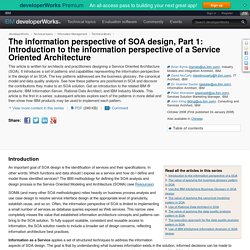
In other words: Which functions and data should I expose as a service and how do I define and model those identified services? The IBM methodology for defining the SOA analysis and design process is the Service Oriented Modeling and Architecture (SOMA) (see Resources). SOMA (and many other SOA methodologies) relies heavily on business process analysis and use case design to resolve service interface design at the appropriate level of granularity, establish reuse, and so on.
Often, the information perspective of SOA is limited to implementing a small number of services as database queries exposed as Web services. Service Orientation. SOA Patterns. Service Choreography and Orchestration with Conversations PowerPoint presentation. Orchestration vs. Choreography: Debate Over Definitions. With increasing attention given to SOA, it becomes more and more important to standardize (give precise meaning) the terminology used.
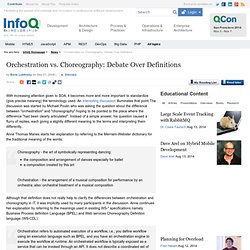
An interesting discussion illuminates that point.The discussion was started by Michael Poulin who was asking the question about the difference between "orchestration" and "choreography" hoping to be pointed to the place where the difference "had been clearly articulated". Instead of a simple answer, his question caused a flurry of replies, each giving a slightly different meaning to the terms and interpreting them differently..
Anne Thomas Manes starts her explanation by referring to the Merriam-Webster dictionary for the traditional meaning of the words: Conversations between loosely coupled services. EIP : Qu’est ce que c’est. 25 janvier 2010 Dans l’article sur JBI, j’ai mentionné à de nombreuses reprise le terme EIP.
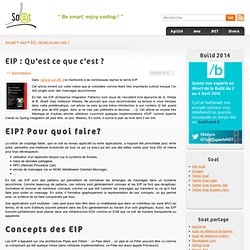
Cet article revient sur cette notion que je considère comme étant très importante surtout lorsque l’on doit jongler avec des messages asynchrones. En fait, les EIP (Enterprise Integration Patterns) sont issus de l’excellent livre éponyme de G. Hohpe et B. Woolf chez Addisson Wesley. La notion de couplage faible, que ce soit au niveau applicatif ou entre applications, a toujours été primordiale pour, entre autre, permettre une meilleure évolutivité (et tous ce qui va avec) qui est une des bêtes noires pour tous DSI et même pour tous développeurs. utilisation d’un répertoire tampon sur le système de fichiers,base de données partagées,RPC (Remote Procedure Call),envoie de messages via un MOM (Middleware Oriented Message),… En fait, les EIP sont des patterns qui permettent de normaliser les échanges de messages dans un système asynchrone.
En outre, les EIP décrivent : Briques Fondatrices de l’Architecture Orientée Services Passerelle de sécurisation et Référentiel de services - SolConnect_13_IND03.pdf. SOA pour les nuls - astinux. Réussir votre SOA : Un guide pratique en 10 questions (1/3) L’un des facteurs clé pour la réussite de la mise en place d’une architecture orientée services, c’est de parvenir à identifier et mettre en œuvre des services à forte valeur ajoutée.
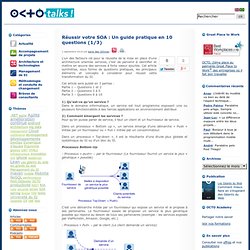
Cet article synthétise, sous forme de questions pratiques, les principaux éléments et concepts à considérer pour réussir cette transformation du SI. The 9 Principles Of Soa Design. Service-oriented Architecture (SOA) is as simple as can be.
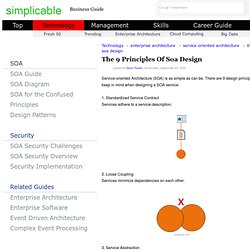
There are 9 design principles to keep in mind when designing a SOA service: 1. Standardized Service Contract Services adhere to a service-description. 2. Loose Coupling Services minimize dependencies on each other. 3. 4. 5. Baby Steps to SOA – Step One: Analyze and Plan. In the continuing Baby Steps to SOA series, we follow Doug and his IT team behind BuyMyWidget.com as they take steps to renovate their digital asset architecture.
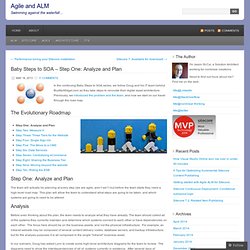
Previously, we introduced the problem and the team, and now we start on our travel through the road map. The Evolutionary Roadmap Step One: Analyze and Plan The team will actually be planning at every step (we are agile, aren’t we?) But before the team starts they need a high-level road map. Analysis Before even thinking about the plan, the team needs to analyze what they have already.
In our scenario, Doug has asked Lynn to create some high-level architecture diagrams for the team to review. While Lynn was doing this, Doug was busy pulling together data on their budget spend from the last year. Later that week, Doug calls the team together to review the information that he and Lynn have gathered. On the second pass, the team uses Doug’s cost information to see where the budget is being spent the most.
Making the Plan How? Soa-technicalvision-nagappan.pdf. Chapter 1: Service Oriented Architecture (SOA) “SOAs are like snowflakes – no two are alike.” - David Linthicum Consultant Contents.
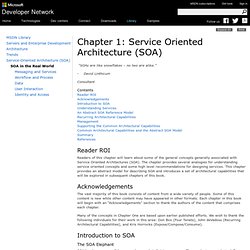
Microsoft Word - SOAPGPart3.doc - SOAPGPart3.pdf. Microsoft Word - SOAPGPart2.doc - SOAPGPart2.pdf. Microsoft Word - SOAPGPart1.doc - SOAPGPart1.pdf. Service-oriented modeling and architecture. How to identify, specify, and realize services for your SOA Ali ArsanjaniPublished on November 09, 2004 There has been a lot of buzz and hype -- some factual, some not so well-founded -- surrounding the opportunities presented by Service-oriented Architectures (SOA) and its implementation as Web services.
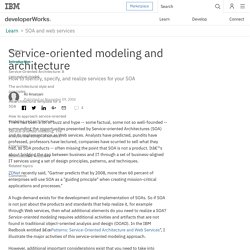
Analysts have predicted, pundits have professed, professors have lectured, companies have scurried to sell what they had, as SOA products -- often missing the point that SOA is not a product. It’s about bridging the gap between business and IT through a set of business-aligned IT services using a set of design principles, patterns, and techniques. ZDNet recently said, "Gartner predicts that by 2008, more than 60 percent of enterprises will use SOA as a "guiding principle" when creating mission-critical applications and processes.
" A huge demand exists for the development and implementation of SOAs. However, additional important considerations exist that you need to take into account. Service-oriented architecture. See also the client-server model, a progenitor concept A Service-Oriented Architecture (SOA) is a design pattern in which software/application components provide services to other software/application components via a protocol, typically over a network and in a loosely-coupled way.
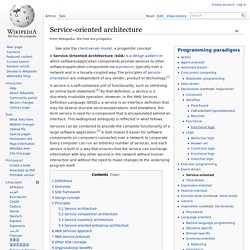
The principles of service-orientation are independent of any vendor, product or technology.[1] A service is a self-contained unit of functionality, such as retrieving an online bank statement.[2] By that definition, a service is a discretely invokable operation. However, in the Web Services Definition Language (WSDL), a service is an interface definition that may list several discrete services/operations. And elsewhere, the term service is used for a component that is encapsulated behind an interface.